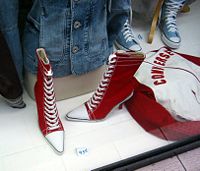Converse (brand)
| File:Converse logo.png | |
| Company type | Subsidiary of Nike |
|---|---|
| Industry | sporting goods |
| Founded | 1908 in Malden, Massachusetts |
| Headquarters | North Andover, Massachusetts |
Key people | , Founder |
| Products | shoes, apparel |
| Website | www.converse.com |
Converse is an American shoe company which has been making shoes since the early 20th century. As of 2007, Converse also produces a wide range of occupational safety shoes that resemble their regular athletic shoes, which include the popular 'Chuck Taylors' (also known as Conies or All Stars). Converse have just released a new set of Chuck Taylors called the Century Shoes (2008. the New Century shoes are funky and colourful with many different patterns. Converse are extremely popular around the world today, these shoes are more than just fashion they are also working with 1hund(red) to raise money for AIDS.
History
1908–1941: Early days and Chuck Taylor
In his late 30s, Marquis M. Converse, who was previously a respected manager at a footwear manufacturing firm, opened the Converse Rubber Shoe Company (also known as the Boston Rubber Shoe Company) in Malden, Massachusetts in 1908. The company was a rubber shoe manufacturer, providing winterized rubber soled footwear for men, women, and children. By 1910, Converse was producing 4,000 shoes daily, but it wasn't until 1915 that the company began manufacturing athletic shoes for tennis. The company's main turning point came in 1917 when the Converse All-Star basketball shoe was introduced. Then in 1921, a basketball player named Charles H. or "Chuck" Taylor walked into Converse complaining of sore feet. Converse gave him a job. He worked as a salesman and ambassador, promoting the shoes around the United States, and in 1923 his signature was added to the All Star patch. He tirelessly continued this work until shortly before his death in 1969. Converse also customized shoes for the New York Renaissance (the "Rens"), basketball's first all African American pro basketball team. The Converse brand is generally considered to be synonymous with basketball shoes.
1941–Present: War, bankruptcy, and new management

When the United States entered World War II in 1941, Converse shifted production to manufacturing footwear, apparel, boots, parkas, rubber protective suits, and ponchos for pilots and troops. Widely popular during the 1950s and 1960s, Converse promoted a distinctly American image with its Converse Yearbook. Artist Charles Kerins created cover art that celebrated Converse's role in the lives of High School and College atheletes, as the essential sports shoe.
Converse lost much of its apparent near-monopoly from the 1970s onward, with the surge of new competitors, including Adidas, then Nike, then a decade later Reebok, who introduced radical new designs to the market. Converse found themselves no longer the official shoe of the National Basketball Association, a title they had relished for many years. This loss of market share, combined with poor business decisions forced Converse to file for bankruptcy on January 22, 2001. When the company subsequently changed hands that year, the last factory in the United States was closed. Thereafter, manufacturing for the American market was no longer performed in the United States, but instead in a number of Asian countries, including China, Indonesia, Lithuania and Vietnam.
On July 9, 2003, the company accepted a $305 million purchase offer from rival Nike.
Current NBA players wearing Converse include Dwyane Wade, Kirk Hinrich, Jameer Nelson, Andre Miller, Kyle Korver, Alando Tucker, Acie Law, Udonis Haslem, Maurice Evans, Orien Greene and Mike Sweetney.
Style


Chuck Taylor All Star basketball shoe
The Chuck Taylor All Star shoe has developed a number of nicknames over the years, such as: "Cons", "Connies", "Chuckers", "Chucks", "Converse", "Chuckies", "Chuckie T's", or "Chucker Boots" for the higher styles. For decades the Chuck Taylor All Star basketball shoe only came in black, with a white varient released in 1947. Under pressure from basketball teams it was decided in 1966 to manufacture other colors. Different materials also began to be used, starting in the 1970s, including leather, suede and vinyl, and even hemp, rather than just canvas. Besides high-tops, low-cuts and later knee-high versions were produced. After Converse was bought operations were moved from the United States to overseas, although the design has had few alterations. The fabric is no longer 2-ply cotton canvas but 1-ply "textile" and many wearers have noticed different patterns of wear.
The Weapon
In 1986, Converse released "The Weapon" basketball shoe. Manufactured in many color schemes to match the kit colors of basketball teams, it has been available in both high-top and low cut varieties. The unique aspect of this shoe is the leather construction throughout, including the inside heel which is also heavily padded for comfort. Converse re-released "The Weapon" in 2002 and "The Loaded Weapon" in 2003.
Special Editions
There have been made several special editions of Converse shoes, such as the Kurt Cobain model.
Converse athletes
- Dwyane Wade
- Elton Brand
- Kirk Hinrich
- Jameer Nelson
- Udonis Haslem
- Acie Law
- Kyle Korver
- Andre Miller
- Maurice Evans
- Alando Tucker
- Orien Greene
- Mike Sweetney
Converse college teams
- Marquette Golden Eagles
- Western Kentucky Hilltoppers (Shoes Only)
Corporate Responsibility and criticism
This article needs additional citations for verification. (May 2008) |
Converse is owned by Nike, a company that on multiple occasions has been criticized for its use of sweatshop labor. In response to that criticism, Nike has worked to lead the footwear and apparel industries in eliminating sweatshop labor.[citation needed] For example, in its 2004 Corporate Responsibility Report, Nike publicly released a list of the factories it contracts with. This move, a first in the apparel and footwear industries, allows third-party verification of factory conditions by trade unions and NGOs.
